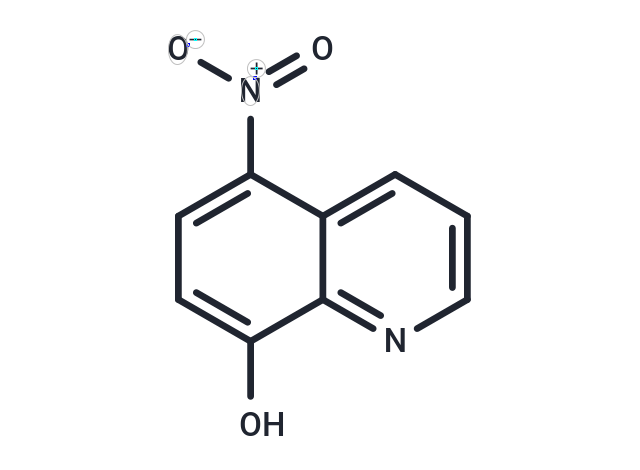Shopping Cart
- Remove All
 Your shopping cart is currently empty
Your shopping cart is currently empty

Nitroxoline (5-nitroquinolin-8-ol) is a urinary antibacterial agent active against susceptible gram-positive and gram-negative organisms commonly found in urinary tract infections.

| Pack Size | Price | Availability | Quantity |
|---|---|---|---|
| 1 g | $30 | In Stock | |
| 1 mL x 10 mM (in DMSO) | $29 | In Stock |
| Description | Nitroxoline (5-nitroquinolin-8-ol) is a urinary antibacterial agent active against susceptible gram-positive and gram-negative organisms commonly found in urinary tract infections. |
| In vitro | Nitroxoline significantly reduces extracellular DQ-collagen IV degradation by all evaluated cancer cell lines using spectrofluorimetry. Nitroxoline also markedly decreases tumor cell invasion monitored in real time and reduces the invasive growth of multicellular tumor spheroids, used as a 3D in vitromodel of tumor invasion. Endothelial tube formation is significantly reduced by nitroxoline in an in vitro angiogenesis assay[1]. |
| In vivo | Nitroxoline significantly abrogates tumor growth, angiogenesis and metastasis in vivo in LPB fibrosarcoma and MMTV-PyMT breast cancer mouse models[1]. |
| Kinase Assay | In Vitro Kinase Assays : The potency of SP600125 towards kinases, including MPS1, JNK, and Aurora kinase A, is determined based on the specific measurement of radioactive phosphotransfer to the substrate. For each enzyme, the absolute Km values for ATP and the specific substrate are initially determined and each assay is then run at optimized [ATP] (2·αKm) and [substrate] (5·Km) concentrations. MPS1 activity is measured using 5 nM of MPS1 recombinant protein in 50 mM HEPES pH 7.5, 2.5 mM MgCl2, 1 mM MnCl2, 1 mM DTT, 3 μM NaVO3, 2 mM β-glycerophosphate, 0.2 mg/mL BSA, 200 μM P38-βtide substrate-peptide (KRQADEEMTGYVATRWYRAE), and 8 μM ATP with 1.5 nM 33P-γ-ATP. Ten serial 1:3 dilutions (from 30 μM to 1.5 nM) of SP600125 are tested and IC50 determined. |
| Cell Research | cell suspension are seeded in the wells of an E-plate 16 according to the manufacturer's instructions. After seeding, the CI is monitored every 15 min. After ∼10 h (MCF-10A neoT and MMTV-PyMT), 14 h (U-87 MG) or 24 h (LPB), when the cells are in their log phase of growth, 50 μl of the compound or 0.1% DMSO is added, and the experiment allowed to run for 72 h. Once every 24 h the medium is replaced with fresh medium containing the inhibitor or suitable control to prevent cell death due to medium depletion. Compounds and their concentrations are: nitroxoline (5 μM) and CA-074 (5 μM) for all cell lines other than MCF-10A neoT cell line, where nitroxoline was used at 2.5 μM. All measurements were performed in quadruplicate. (Only for Reference) |
| Alias | 8-Hydroxy-5-nitroquinoline, 5-nitroquinolin-8-ol, 5-Nitro-8-quinolinol, 5-Nitro-8-hydroxyquinoline |
| Molecular Weight | 190.16 |
| Formula | C9H6N2O3 |
| Cas No. | 4008-48-4 |
| Smiles | OC1=CC=C(C2=CC=CN=C12)[N+]([O-])=O |
| Relative Density. | 1.3907 g/cm3 (Estimated) |
| Storage | Powder: -20°C for 3 years | In solvent: -80°C for 1 year | Shipping with blue ice. | |||||||||||||||||||||||||||||||||||
| Solubility Information | H2O: < 1 mg/mL (insoluble or slightly soluble) Ethanol: < 1 mg/mL (insoluble or slightly soluble) DMSO: 65 mg/mL (341.82 mM), Sonication is recommended. | |||||||||||||||||||||||||||||||||||
Solution Preparation Table | ||||||||||||||||||||||||||||||||||||
DMSO
| ||||||||||||||||||||||||||||||||||||

Copyright © 2015-2025 TargetMol Chemicals Inc. All Rights Reserved.